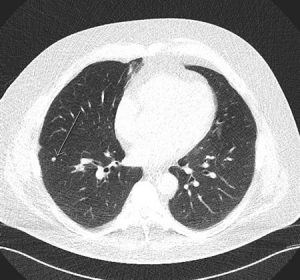Early Detection through Lung Cancer Screening

Arrow shows a benign nodule in the right lower lobe visualized on a low-dose screening CT. Image courtesy of Dr. Thomas Frauenfelder and AuntMinnieEurope.
Lung cancer is the second most common cancer and the leading cause of cancer death, representing almost 25% of all cancer deaths. According to the American Cancer Society, the chance of developing lung cancer in one’s lifetime is around 1 in 16.
A key to surviving lung cancer is early detection. If lung cancer is diagnosed before it has spread to other parts of the body, the average 5-year survival is 63%, compared to a rate of 35% when lung cancer has spread regionally, and 7% when the cancer has spread to distant parts of the body. Unfortunately, less than 1 in 7 patients with lung cancer will be diagnosed in the earliest stages of the disease, when treatment options are most effective. Fortunately, low-dose chest computed tomography (CT) has emerged as one of the best diagnostic tools available to detect lung cancer.
Early diagnosis of lung cancer can decrease lung cancer mortality by 14-20% among high-risk patient populations. There are approximately 8 million Americans that qualify as high risk for lung cancer who would potentially benefit from annual screening with low-dose CT scans. Screening this population can prevent many deaths and increase years of life for many more.
Please, consult with your physician to determine if you meet eligibility requirements for a low dose chest CT. Low-dose CT scans are noninvasive, only takes a few minutes, and painless. Most importantly, it can save your life or the life of a loved one.
Medicare Beneficiaries:
For Medicare beneficiaries to be eligible for lung cancer screenings with low-dose CT, they must meet all of the following criteria:
- Age 55-77 years
- Asymptomatic (no signs or symptoms of lung cancer)
- At least a 30 pack-year smoking history (one pack-year = smoking one pack per day for one year; 1 pack = 20 cigarettes)
- Current smoker or one who has quit smoking within the last 15 years
- Receive a written order for lung cancer screening with low dose CT
Written orders for lung cancer low dose CT screenings must be appropriately documented in the beneficiary’s medical records, and must contain the following information:
- Date of birth
- Actual pack-year smoking history
- Current smoking status and, for former smokers, the number of years since quitting smoking
- Statement that the beneficiary is asymptomatic (no signs or symptoms of lung cancer)
Please consult your physician, as new recommendations from the US Preventative Service Task Force in 2021 have expanded those who are recommended to receive annual screening for lung cancer to adults aged 50-80 who have a 20 pack-year smoking history and currently smoke or have quit within the last 15 years.
